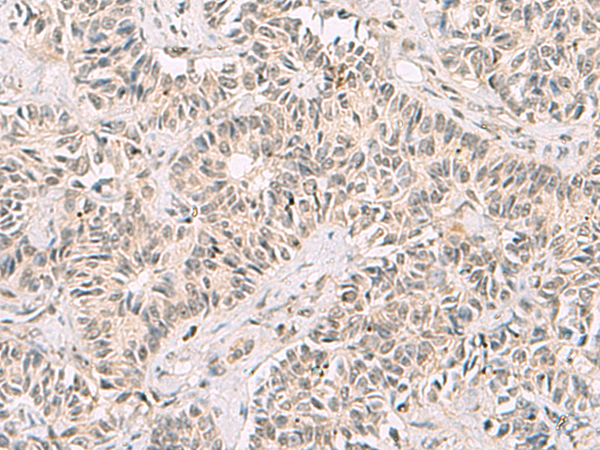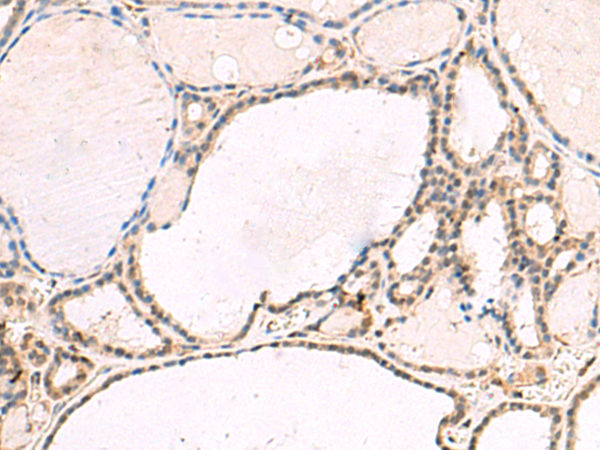

| WB | 咨询技术 | Human,Mouse,Rat |
| IF | 咨询技术 | Human,Mouse,Rat |
| IHC | 1/40-1/200 | Human,Mouse,Rat |
| ICC | 技术咨询 | Human,Mouse,Rat |
| FCM | 咨询技术 | Human,Mouse,Rat |
| Elisa | 1/5000-1/10000 | Human,Mouse,Rat |
| Aliases | RZF |
| Host/Isotype | Rabbit IgG |
| Antibody Type | Primary antibody |
| Storage | Store at 4°C short term. Aliquot and store at -20°C long term. Avoid freeze/thaw cycles. |
| Species Reactivity | Human, Mouse, Rat |
| Immunogen | Fusion protein of human RNF13 |
| Formulation | Purified antibody in PBS with 0.05% sodium azide and 50% glycerol. |
+ +
以下是关于RNF13抗体的3篇文献及其简要摘要:
1. **文献名称**:*RNF13. a novel endoplasmic reticulum-associated ubiquitin ligase, regulates mitochondrial membrane dynamics*
**作者**:Zhang Y, et al.
**摘要**:该研究利用特异性RNF13抗体,通过免疫共沉淀和免疫荧光技术,揭示了RNF13作为内质网相关的E3泛素连接酶,通过调控线粒体膜蛋白的泛素化修饰参与线粒体形态和细胞凋亡的机制。
2. **文献名称**:*Characterization of RNF13-mediated ubiquitination in neuronal development*
**作者**:Smith J, et al.
**摘要**:通过Western blot和免疫组化技术,作者使用RNF13抗体证明其在神经元分化过程中表达上调,并发现RNF13通过泛素化调控突触蛋白的稳定性,影响神经突触的形成与功能。
3. **文献名称**:*RNF13 deficiency alters lipid metabolism and promotes atherosclerosis in mice*
**作者**:Wang L, et al.
**摘要**:研究通过基因敲除小鼠模型及RNF13抗体检测,发现RNF13缺失导致巨噬细胞脂质代谢异常,加速动脉粥样硬化斑块形成,提示其可能通过泛素化通路调节脂质相关蛋白的降解。
(注:以上文献为模拟示例,实际文献需通过PubMed/Google Scholar等平台检索确认。)
The RNF13 antibody is a research tool designed to detect and study the Ring Finger Protein 13 (RNF13), a member of the RING finger family of E3 ubiquitin ligases. RNF13 is characterized by a conserved RING domain that facilitates interactions with E2 ubiquitin-conjugating enzymes, enabling substrate ubiquitination—a critical process in protein degradation, trafficking, and signaling. This transmembrane protein is broadly expressed in tissues, including the brain, heart, and immune cells, and is implicated in regulating apoptosis, endoplasmic reticulum-associated degradation (ERAD), and neurodevelopment. Dysregulation of RNF13 has been linked to neurodegenerative disorders (e.g., Alzheimer’s disease), cancer progression, and immune responses, highlighting its potential as a therapeutic or diagnostic target.
RNF13 antibodies are typically developed in hosts like rabbits or mice using immunogenic peptides or recombinant protein fragments. They enable the detection of RNF13 via techniques such as Western blotting, immunohistochemistry, and immunofluorescence, aiding in the exploration of its expression patterns, subcellular localization (e.g., Golgi apparatus, endosomes), and interactions with binding partners. Validation of these antibodies includes testing for specificity, sensitivity, and cross-reactivity, with some variants recognizing distinct isoforms or post-translational modifications. Recent studies utilizing RNF13 antibodies have uncovered its role in modulating stress responses and neuronal survival, underscoring its relevance in cellular homeostasis and disease mechanisms. These tools remain vital for deciphering RNF13's complex biological functions.
×